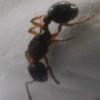I found a bunch of Dolopomyrmex pilatus queens floating around a pool, here in Irvine (Southern California). I got four queens of this species. Like Drew's experience, they are pretty slow and sluggish (no aggression at all either). I also got three Hypoponera queens (which are much faster and more aggressive), so tonight was the night of flying subterranean ants.
I kept all the Dolopomyrmex queens together in one test tube. From my experience, most small ant species tend to have multiple queens (or at least will accept other queens) and their lack of aggression, shouldn't have any issues at all. I also gave them (and the Hypoponera) honey, which the Dolopomyrmex (all four) went to right away (in their slow movement) and started eating.
I'll be pretty much feeding both species. Now, Ponera needs to forage in founding stages...and Hypoponera queens look pretty much the same and will probably need food as well. I'll be feeding Dolopomyrmex as well as I assume they need food in their founding stages too. Drew never fed his as far as I know and didn't have much luck with his. I don't think he kept any together either, which tends to greatly increase success rate. Since their subterranean, and as far as I know, a lot of subterranean queens tend to forage in founding stages...I'll be treating them exactly like the Hypoponera queens I have. Except, both will probably have different food they like.
Besides, if the queens eat...great. I tend to feed non-foraging queens anyway. I find much better success with feeding ants, and if they don't accept the food, nothing lost.
Edited by Vendayn, May 25 2015 - 11:10 AM.


















